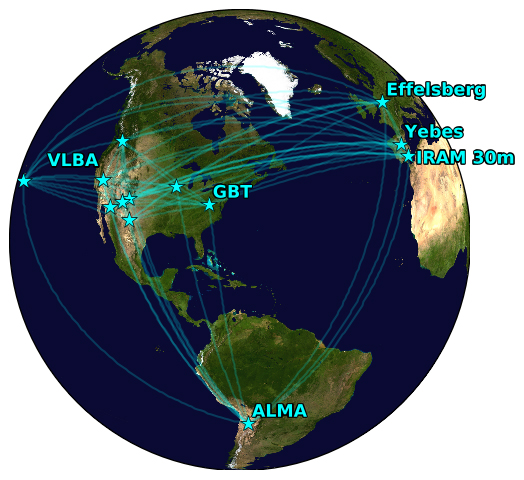News
Lifting the veil on the black hole at the heart of our Galaxy
Astronomers have found that the emission from the supermassive black hole Sagittarius A* (Sgr A*) at the center of our Galaxy comes from a smaller region than previously thought. This may indicate that a radio jet from Sgr A* is pointed almost toward us. The paper, led by the Nijmegen PhD student Sara Issaoun, is published in the Astrophysical Journal.
 |
| Top left: simulation of Sgr A* at 86 GHz. Top right: simulation with added effects of scattering. Bottom right: scattered image from the observations, this is how we see Sgr A* on the sky. Bottom left: the unscattered image, after removing the effects of scattering in our line of sight, this is how Sgr A* really looks like. Credit: S. Issaoun, M. Mościbrodzka, Radboud University/ M. D. Johnson, CfA |
So far, a foggy cloud of hot gas has prevented us from making sharp images of the supermassive black hole Sgr A*, causing doubt on its true nature. Astronomers have used now the GMVA, a global network of telescopes, including the IRAM 30-meter and, for the first time, the ALMA observatory in northern Chile, to peer through this fog into the black hole. The source, however, keeps surprising them: its emission region is so small that the source may actually have to point directly at us.
Observing at a frequency of 86 GHz with the technique of Very Long Baseline Interferometry (VLBI), which combines many telescopes to form a virtual telescope of the size of the Earth, the team succeeded in mapping out the exact properties of the light scattering blocking our view of Sgr A*. To remove the scattering and obtain the image, the team used a technique developed by Michael Johnson of the Harvard-Smithsonian Center for Astrophysics (CfA). "Even though scattering blurs and distorts the image of Sgr A*, the incredible resolution of these observations allowed us to pin down the exact properties of the scattering,” says Johnson. “We could then remove most of the effects from scattering and begin to see what things look like near the black hole”.
The high quality of the unscattered image has allowed the team to constrain theoretical models for the gas around Sgr A*. The bulk of the radio emission is coming from a region of a small size: a mere 300 millionth of an arc degree. “This may indicate that the radio emission is produced in a disk of infalling gas rather than by a radio jet,” explains Issaoun, who has tested several computer models against the data. “However, that would make Sgr A* an exception compared to other radio emitting black holes. The alternative could be that the radio jet is pointing almost at us”.
Heino Falcke from Radboud University, calls this statement very unusual, but he also no longer rules it out. Last year, Falcke would have considered this a contrived model, but recently the GRAVITY team came to a similar conclusion using ESO’s Very Large Telescope Interferometer of optical telescopes and an independent technique. “Maybe this is true after all”, concludes Falcke, “and we are looking at this beast from a very special vantage point.”
 |
| The Global Millimeter VLBI Array. Credit: S. Issaoun, Radboud University/ D. Pesce, CfA |
Sgr A* is the nearest supermassive black hole and 'weighs' about 4 million solar masses. Its apparent size on the sky is less than a 100 millionth of an arc degree, which corresponds to the size of a tennis ball on the moon as seen from the Earth. “The black hole is so small that only VLBI can provide the angular resolution needed to resolve its structure”, says Pablo Torne, astronomer in support on the observations from the IRAM 30-meter telescope. “The first observations of Sgr A* at 86 GHz date from 26 years ago, with only a handful of telescopes. Over the years, the quality of the data has improved steadily as more telescopes join,” adds J. Anton Zensus, director of the Max Planck Institute for Radio Astronomy.
Future observations at different wavelengths will provide additional clues for this source, which holds the key to a better understanding of black holes, the most exotic objects in the known universe.
Further information:
Contact:
Sara Issaoun, Radboud University
Tel: +31 6 84526627
E-mail: s.issaoun@astro.ru.nl
Pablo Torne, IRAM
Tel: +34 958 805 454 ext:224
E-mail: torne@iram.es
Article:
The Size, Shape, and Scattering of Sagittarius A * at 86 GHz: First VLBI with ALMA
S. Issaoun, M. D. Johnson, L. Blackburn, C. D. Brinkerink, M. Mościbrodzka, A. Chael, C. Goddi, I. Martí-Vidal, J. Wagner, S. S. Doeleman, H. Falcke, T. P. Krichbaum, K. Akiyama, U. Bach, K. L. Bouman, G. C. Bower, A. Broderick, I. Cho, G. Crew, J. Dexter, V. Fish, R. Gold, J. L. Gómez, K. Hada, A. Hernández-Gómez, M. Janßen M. Kino, M. Kramer, L. Loinard, R.-S. Lu, S. Markoff, D. P. Marrone, L. D. Matthews, J. M. Moran, C. Müller, F. Roelofs, E. Ros, H. Rottmann, S. Sanchez, R. P. J. Tilanus, P. de Vicente, M. Wielgus, J. A. Zensus and G.-Y. Zhao.

